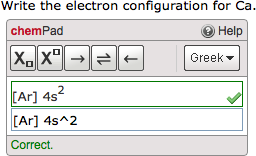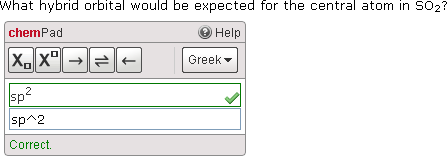When you create chemPad questions that are answered with electron configuration notation, your students can use either numerical or Aufbau order, but answer keys are shown in Aufbau order, for example, [Ar] 4s2 3d10. You can choose the kinds of electron configuration notation to allow in your students' responses.
Full requires your students to use full notation — for example, 1s2 2s2 2p2.
Noble requires your students to use noble gas notation — for example, [He] 2s2 2p2.
Either lets your students use either full notation — for example, 1s2 2s2 2p2 — or noble gas notation — for example, [He] 2s2 2p2.
Orbit lets your students use variants for orbital hybridization, for example, dsp3 or sp3d, that are considered equivalent.
Example chemPad Question (Electron Configuration)
The following table summarizes an actual question.
|
QID |
|
|---|---|
|
Name |
|
|
Mode |
|
|
Question |
|
|
Answer |
|
|
Display to Students |

|
Example chemPad Question (Orbital Hybridization)
The following table summarizes an actual question.
|
QID |
|
|---|---|
|
Name |
|
|
Mode |
|
|
Question |
|
|
Answer |
|
|
Display to Students |

|